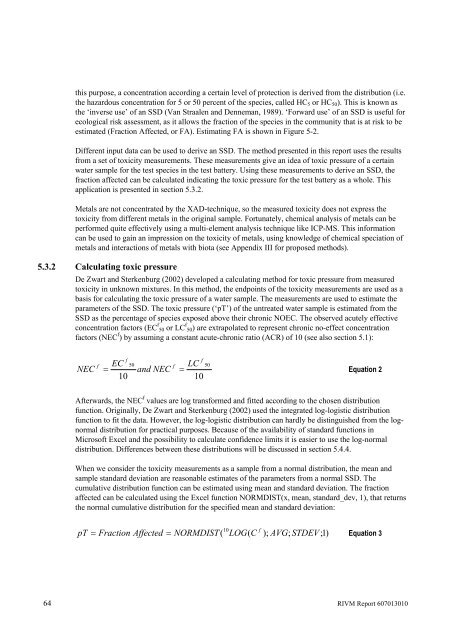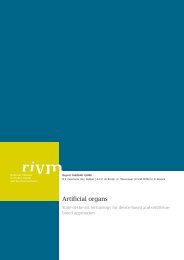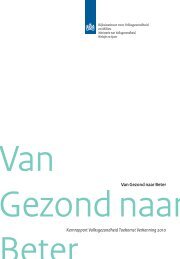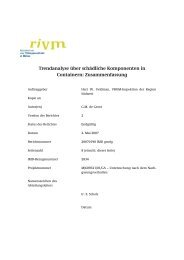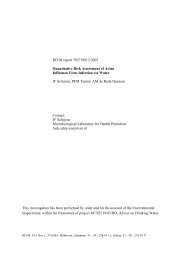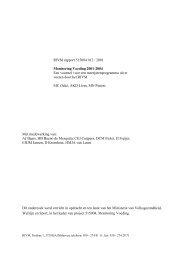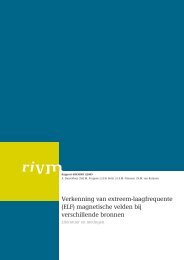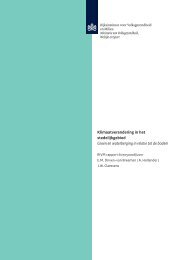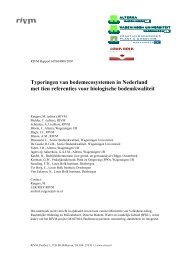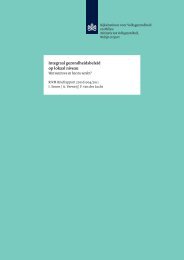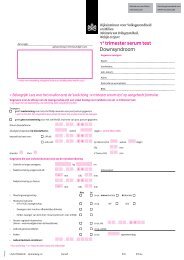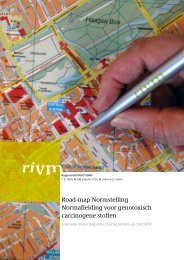Toxicity measurements in concentrated water samples - Rivm
Toxicity measurements in concentrated water samples - Rivm
Toxicity measurements in concentrated water samples - Rivm
Create successful ePaper yourself
Turn your PDF publications into a flip-book with our unique Google optimized e-Paper software.
this purpose, a concentration accord<strong>in</strong>g a certa<strong>in</strong> level of protection is derived from the distribution (i.e.<br />
the hazardous concentration for 5 or 50 percent of the species, called HC5 or HC50). This is known as<br />
the ‘<strong>in</strong>verse use’ of an SSD (Van Straalen and Denneman, 1989). ‘Forward use’ of an SSD is useful for<br />
ecological risk assessment, as it allows the fraction of the species <strong>in</strong> the community that is at risk to be<br />
estimated (Fraction Affected, or FA). Estimat<strong>in</strong>g FA is shown <strong>in</strong> Figure 5-2.<br />
Different <strong>in</strong>put data can be used to derive an SSD. The method presented <strong>in</strong> this report uses the results<br />
from a set of toxicity <strong>measurements</strong>. These <strong>measurements</strong> give an idea of toxic pressure of a certa<strong>in</strong><br />
<strong>water</strong> sample for the test species <strong>in</strong> the test battery. Us<strong>in</strong>g these <strong>measurements</strong> to derive an SSD, the<br />
fraction affected can be calculated <strong>in</strong>dicat<strong>in</strong>g the toxic pressure for the test battery as a whole. This<br />
application is presented <strong>in</strong> section 5.3.2.<br />
Metals are not <strong>concentrated</strong> by the XAD-technique, so the measured toxicity does not express the<br />
toxicity from different metals <strong>in</strong> the orig<strong>in</strong>al sample. Fortunately, chemical analysis of metals can be<br />
performed quite effectively us<strong>in</strong>g a multi-element analysis technique like ICP-MS. This <strong>in</strong>formation<br />
can be used to ga<strong>in</strong> an impression on the toxicity of metals, us<strong>in</strong>g knowledge of chemical speciation of<br />
metals and <strong>in</strong>teractions of metals with biota (see Appendix III for proposed methods).<br />
5.3.2 Calculat<strong>in</strong>g toxic pressure<br />
De Zwart and Sterkenburg (2002) developed a calculat<strong>in</strong>g method for toxic pressure from measured<br />
toxicity <strong>in</strong> unknown mixtures. In this method, the endpo<strong>in</strong>ts of the toxicity <strong>measurements</strong> are used as a<br />
basis for calculat<strong>in</strong>g the toxic pressure of a <strong>water</strong> sample. The <strong>measurements</strong> are used to estimate the<br />
parameters of the SSD. The toxic pressure (‘pT’) of the untreated <strong>water</strong> sample is estimated from the<br />
SSD as the percentage of species exposed above their chronic NOEC. The observed acutely effective<br />
concentration factors (EC f 50 or LC f 50) are extrapolated to represent chronic no-effect concentration<br />
factors (NEC f ) by assum<strong>in</strong>g a constant acute-chronic ratio (ACR) of 10 (see also section 5.1):<br />
f<br />
f<br />
f EC 50<br />
f LC 50<br />
NEC = and NEC =<br />
Equation 2<br />
10<br />
10<br />
Afterwards, the NEC f values are log transformed and fitted accord<strong>in</strong>g to the chosen distribution<br />
function. Orig<strong>in</strong>ally, De Zwart and Sterkenburg (2002) used the <strong>in</strong>tegrated log-logistic distribution<br />
function to fit the data. However, the log-logistic distribution can hardly be dist<strong>in</strong>guished from the lognormal<br />
distribution for practical purposes. Because of the availability of standard functions <strong>in</strong><br />
Microsoft Excel and the possibility to calculate confidence limits it is easier to use the log-normal<br />
distribution. Differences between these distributions will be discussed <strong>in</strong> section 5.4.4.<br />
When we consider the toxicity <strong>measurements</strong> as a sample from a normal distribution, the mean and<br />
sample standard deviation are reasonable estimates of the parameters from a normal SSD. The<br />
cumulative distribution function can be estimated us<strong>in</strong>g mean and standard deviation. The fraction<br />
affected can be calculated us<strong>in</strong>g the Excel function NORMDIST(x, mean, standard_dev, 1), that returns<br />
the normal cumulative distribution for the specified mean and standard deviation:<br />
( ( ); ; ; 1)<br />
10<br />
f<br />
pT = Fraction Affected = NORMDIST LOG C AVG STDEV Equation 3<br />
64 RIVM Report 607013010


